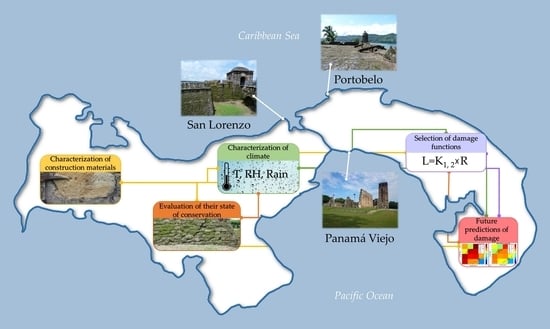How Can Climate Change Affect the UNESCO Cultural Heritage Sites in Panama?
Abstract
:1. Introduction
1.1. Overview of Environmental Impact on Cultural Heritage
1.2. Panamanian Climate Classification
- Af: “Equatorial rainforest, fully humid”;
- Am: “Equatorial monsoon”;
- Partially, Aw: “Equatorial savannah with dry winter”;
2. Materials and Methods
2.1. Selection of Monitoring Stations and Climate Model
2.2. Analysis of Construction Materials
- Stereomicroscope observations using an Optika SZ6745TR equipped with a webcam, MOTICAM 2005 5.0 Mp, and Moticam Image Plus 2.0 software, were utilized for performing preliminary analyses of the bulk samples.
- Polarized light microscopy (PLM) investigations were performed for the analysis of uncovered thin sections, partially polished in order to observe in both transmitted and reflected light, using an Olympus BX 51 microscope equipped with scanner-camera and the MICROMAX software “Primoplus_32” vers. 8.11.02. Furthermore, for evaluating the state of conservation, the thin sections were realized through transversal cuts from the external to the inner part of the samples.
- X-ray powder diffraction (XRPD) analysis was performed for determining the mineralogical phases present using a Philips PW 1730 diffractometer equipped with a copper anticathode and a nickel filter. The measurement conditions have a diffraction interval of 2θ, between 5° and 50°, and a 2°/min step at 40 kV voltage and 30 mA current intensity. In addition, further analyses were performed in order to verify the clay minerals present in several samples, utilizing a Bruker AXS D8, in Bragg-Brentano geometry, equipped with an X-ray tube and a SolX solid state detector, working in low-temperature through Peltier cooling system. The samples for these techniques underwent a powdering process, utilizing two mills, firstly a jaw crusher and secondly a mortar grinder with agate jar and pestle. For materials showing high hardness, the process was finished by manual grinding with an agate mortar.
- Environmental scanning electron microscopy and microchemical investigations (ESEM-EDS); analyses were carried out to determine the elemental composition of specific areas of interest, already observed by stereomicroscope and PLM investigations on both bulk and thin sections. The instrument utilized a ZEISS EVO LS 10 with LaB6 source.
- X-ray fluorescence (XRF) was performed on powder pellets (see XRPD section for powdering process) pressed with boric acid powder as a binder using a wavelength-dispersive automated ARL Advant’X spectrometer. Accuracy and precision for major elements were estimated 2%–5%; trace elements (above 10 ppm) were estimated at greater than 10%.
- Mercury intrusion porosimetry (MIP) was performed to understand the porosimetry features of the materials and to index of their state of conservation. Specimens that showed enough material (~1 cm × 1 cm × 1 cm to 2 cm × 2 cm × 2 cm) were selected and analysed by a porosimeter, PASCAL 240, THERMO SCIENTIFIC.
- Ion chromatography (IC) analyses were performed on samples showing particular patina or superficial alteration phenomena in order to evaluate the possible presence of soluble salts present in the masonry. The selected specimens, powdered (see XRPD section for powdering process) and then solubilized (sample/water ratio 25 mg/~50 g), were investigated by a DIONEX ICS 900. Anions analysis: Column S23 Pre-column G23; cations analysis: Column CS12 Pre-column CG12.
3. Results and Discussion
3.1. Materials Characterisation
3.2. Comparison between Climate Simulations and Monitoring Stations
- Rainfall: Being Po and Pm the observed and modelled daily precipitation and being their long term average over the period 1979–2008 indicated by an overbar, the multiplicative correction factor, fP, is calculated as Equation (1):
- Relative Humidity: The same procedure as for rainfall was applied to relative humidity data, using a multiplicative correction factor to bias correct the model data based on observations. In this case, the correction factor multiplied to the daily model data is fRH (Equation (2)):where is the average over the period 1979–2008 of the daily RH for observations and is the average of the RH for the model.
- Temperature: In this case, an additive correction factor fT is calculated as the difference between the climatological average of the observed daily temperature over the period 1979–2008 and the climatological average of the modelled daily temperature over the same time period, as follows (Equation (3)):
3.3. Selection of Damage Functions
- (1)
- Surface recession, according to Lipfert [46], is due to the effect of rain washout. In particular, for the present study, the Lipfert modified equation has been chosen, according to [15], as follows (4):where:L = K1,2 × R
- L: surface recession per year (μm year−1)
- K1: 18.8 intercept term based on the solubility of CaCO3 in equilibrium with 330 ppm CO2 (μm m−1)
- K2: 21.8 intercept term based on the solubility of CaCO3 in equilibrium with 750 ppm CO2 (μm m−1)
- R: precipitation (m year−1)
- (2)
- Salt transitions cycles have been considered for halite. Indeed, considering the proximity to the sea of all the sites under study and the equilibrium RH (%) and T (°C) of NaCl corresponding to 75.3% at 25 °C and 75.1% at 30 °C, dissolution–crystallisation transformations can occur. Specifically, assuming T as a constant and according to Grossi et al. [17], the frequency of cycles has been calculated counting the number of times the average daily RH crossed the DRH/CRH of 75.3% or 75.1% on consecutive days. Only the transitions that occurred when the humidity was decreasing, therefore passing from liquid to solid state, were counted. Thus, it can be affirmed that the number of transitions is virtually the number of dissolution–crystallisation cycles.
- (3)
- Biomass accumulation, considered as organic carbon accretion on the surfaces, it has been obtained utilizing the Gomez-Bolea et al. function (5) [20]:where the quantity of biomass B (mg) on surface unity (cm−2) is obtained by applying the annual amount of precipitation P (mm) and the annual mean of temperature T (°C).B = exp(−0.964+0.003P−0.01T)
3.4. Damage Evaluation and Future Predictions
4. Conclusions and Future Perspectives
Author Contributions
Funding
Acknowledgments
Conflicts of Interest
References
- Intergovernmental Panel on Climate Change (IPCC). Climate Change 2014: Mitigation of Climate Change; Contribution of Working Group III to the Fifth Assessment. Report of the Intergovernmental Panel on Climate Change; Edenhofer, O., Pichs-Madruga, R., Sokona, Y., Farahani, E., Kadner, S., Seyboth, K., Adler, A., Baum, I., Brunner, S., Eickemeier, P., et al., Eds.; Cambridge University Press: Cambridge, UK; New York, NY, USA, 2014; p. 1454. ISBN 978-1-107-05821-7. [Google Scholar]
- Schneider, S.H.; Kuntz-Duriseti, K.; Azar, C. Costing non-linearities, surprises, and irreversible events. Pac. Asian J. Energy 2000, 10, 81–106. [Google Scholar]
- Bonazza, A.; Maxwell, I.; Drdácky, M.; Vintzileou, E.; Hanus, C.; Ciantelli, C.; De Nuntiis, P.; Oikonomopoulou, E.; Nikolopoulou, V.; Pospíšil, S.; et al. Safeguarding Cultural Heritage from Natural and Man-Made Disasters A Comparative Analysis of Risk Management in the EU; European Union: Brussels, Belgium, 2018; ISBN 978-92-79-73945-3. [Google Scholar]
- European Commission. Commission Staff Working Document—Action Plan on the Sendai Framework for Disaster Risk Reduction 2015–2030, A Disaster Risk-Informed Approach for All EU Policies; European Commission: Brussels, Belgium, 2016.
- Ciantelli, C. Environmental Impact on UNESCO Heritage Sites in Panama; University of Ferrara: Ferrara, Italy, 2017. [Google Scholar]
- Consejo de la Concertación Nacional para el Desarrollo. Plan Estratégico Nacional con Visión de Estado Panamá 2030; Consejo de la Concertación Nacional para el Desarrollo: Panama, Panama, 2017; ISBN 978-9962-663-33-1. [Google Scholar]
- Ministerio de Ambiente. Gobierno de la Republica de Panamá Estrategia Nacional de Cambio Climático de Panamá. Available online: http://www.miambiente.gob.pa/images/stories/documentos_CC/Esp_Info_V.1_ENCCP_15.12.2015.pdf (accessed on 25 June 2018).
- Camuffo, D. Weathering of Building Materials. In Urban Pollution and Changes to Materials and Building Surface; Brimblecombe, P., Ed.; Imperial College Press: London, UK, 2016; pp. 19–64. [Google Scholar]
- Abd El-Aal, A.K. Climate Change and its Impact on Monumental and Historical Buildings towards Conservation and Documentation Ammon temple, Siwa Oasis, Egypt. J. Earth Sci. Clim. Chang. 2016, 7, 339. [Google Scholar] [CrossRef]
- Brimblecombe, P. Refining climate change threats to heritage. J. Inst. Conserv. 2014, 37, 85–93. [Google Scholar] [CrossRef]
- Strlič, M.; Thickett, D.; Taylor, J.; Cassar, M. Damage functions in heritage science. Stud. Conserv. 2013, 58, 80–87. [Google Scholar] [CrossRef]
- Cassar, M.; Pender, R. The impact of climate change on cultural heritage: Evidence and response. In ICOM Committee for Conservation: 14th Triennial Meeting; Verger, I., Ed.; James & James: The Hague, The Netherlands, 2005; pp. 610–616. [Google Scholar]
- Bonazza, A.; Sabbioni, C.; Messina, P.; Guaraldi, C.; De Nuntiis, P. Climate change impact: Mapping thermal stress on Carrara marble in Europe. Sci. Total Environ. 2009, 407, 4506–4512. [Google Scholar] [CrossRef]
- Kucera, V.; Tidblad, J.; Kreislova, K.; Knotkova, D.; Faller, M.; Reiss, D.; Snethlage, R.; Yates, T.; Henriksen, J.; Schreiner, M.; et al. UN/ECE ICP Materials Dose-response Functions for the Multi-pollutant Situation. Water Air Soil Pollut. Focus 2007, 7, 249–258. [Google Scholar] [CrossRef]
- Bonazza, A.; Messina, P.; Sabbioni, C.; Grossi, C.M.; Brimblecombe, P. Mapping the impact of climate change on surface recession of carbonate buildings in Europe. Sci. Total Environ. 2009, 407, 2039–2050. [Google Scholar] [CrossRef] [PubMed]
- Inkpen, R.; Viles, H.; Moses, C.; Baily, B. Modelling the impact of changing atmospheric pollution levels on limestone erosion rates in central London, 1980–2010. Atmos. Environ. 2012, 61, 476–481. [Google Scholar] [CrossRef]
- Grossi, C.M.; Brimblecombe, P.; Menéndez, B.; Benavente, D.; Harris, I.; Déqué, M. Climatology of salt transitions and implications for stone weathering. Sci. Total Environ. 2011, 409, 2577–2585. [Google Scholar] [CrossRef] [PubMed]
- Brimblecombe, P.; Grossi, C.M.; Harris, I. Climate change critical to cultural heritage. In Heritage, Weathering and Conservation; Fort, R., Álvarez de Buergo, M., Gómez-Heras, C., Vázquez-Calvo, C., Eds.; Taylor & Francis: London, UK, 2006; pp. 387–393. [Google Scholar]
- Brimblecombe, P.; Grossi, C.M. Millennium-long damage to building materials in London. Sci. Total Environ. 2009, 407, 1354–1361. [Google Scholar] [CrossRef] [PubMed]
- Gómez-Bolea, A.; Llop, E.; Ariño, X.; Saiz-Jimenez, C.; Bonazza, A.; Messina, P.; Sabbioni, C. Mapping the impact of climate change on biomass accumulation on stone. J. Cult. Herit. 2012, 13, 254–258. [Google Scholar] [CrossRef] [Green Version]
- Sabbioni, C.; Brimblecombe, P.; Cassar, M. The Atlas of Climate Change Impact on European Cultural Heritage Scientific Analysis and Management Strategies; Anthem Press: London, UK; New York, NY, USA, 2012; ISBN 9780857282835. [Google Scholar]
- Huijbregts, Z.; Kramer, R.P.; Martens, M.H.J.; van Schijndel, A.W.M.; Schellen, H.L. A proposed method to assess the damage risk of future climate change to museum objects in historic buildings. Build. Environ. 2012, 55, 43–56. [Google Scholar] [CrossRef]
- Martens, M.H.J. Climate Risk Assessment in Museums: Degradation Risks Determined from Temperature and Relative Humidity Data; Technische Universiteit Eindhoven: Eindhoven, The Netherlands, 2012. [Google Scholar]
- Antretter, F.; Kosmann, S.; Kilian, R.; Holm, A.; Ritter, F.; Wehle, B. Controlled Ventilation of Historic Buildings: Assessment of Impact on the Indoor Environment via Hygrothermal Building Simulation. In Hygrothermal Behavior, Building Pathology and Durability; de Freitas, V.P., Delgado, J.M.P.Q., Eds.; Springer: Berlin/Heidelberg, Germany, 2013; pp. 93–111. ISBN 978-3-642-31158-1. [Google Scholar]
- Kramer, R.; van Schijndel, J.; Schellen, H. Inverse modeling of simplified hygrothermal building models to predict and characterize indoor climates. Build. Environ. 2013, 68, 87–99. [Google Scholar] [CrossRef]
- Leissner, J.; Kaiser, U. Climate for Culture—Built Cultural Heritage in Times of Climate Change; Fraunhofer MOEZ: Leipzig, Germany, 2014; ISBN 978-3-00-048328-8. [Google Scholar]
- Leissner, J.; Kilian, R.; Kotova, L.; Jacob, D.; Mikolajewicz, U.; Broström, T.; Ashley-Smith, J.; Schellen, H.L.; Martens, M.; Van Schijndel, J.; et al. Climate for culture: Assessing the impact of climate change on the future indoor climate in historic buildings using simulations. Herit. Sci. 2015, 3, 38. [Google Scholar] [CrossRef]
- Kӧppen, W. Versuch einer Klassifikation der Klimate, vorzugsweise nach ihren Beziehungen zur Pflanzenwelt (Examination of a climate classification preferably according to its relation to the flora). Geogr. Z. 1900, 6, 593–611, 657–679. [Google Scholar]
- Geiger, R. Klassifikation der Klimate nach W. Kӧppen (Classification of climates after W. Kӧppen). In Landolt-Bӧrnstein—Zahlenwerte und Funktionen aus Physik, Chemie, Astronomie, Geophysik und Technik, alte Serie; Springer: Berlin, Germany, 1954; Volume 3, pp. 603–607. [Google Scholar]
- Kottek, M.; Grieser, J.; Beck, C.; Rudolf, B.; Rubel, F. World Map of the Köppen-Geiger climate classification updated. Meteorol. Z. 2006, 15, 259–263. [Google Scholar] [CrossRef]
- Autoridad Nacional del Ambiente. Atlas Ambiental de la República De Panamá, 1st ed.; Autoridad Nacional del Ambiente: Panama, Panama, 2010; ISBN 978-9962-651-49-9. [Google Scholar]
- Roden, G.I. Sea level variations at Panama. J. Geophys. Res. 1963, 68, 5701–5710. [Google Scholar] [CrossRef]
- Alba Carranza, M.M. Geografía Descriptiva de la República de Panamá, 2nd ed.; El Panamá América: Panama, Panama, 1946. [Google Scholar]
- Jay, D.A. Evolution of tidal amplitudes in the eastern Pacific Ocean. Geophys. Res. Lett. 2009, 36, L04603. [Google Scholar] [CrossRef]
- Strong, N. Rates and patterns of coastal erosion for the Panama Viejo historical and archeological site. In Portland Geological Society of America Annual Meeting; University of Panama: Panama, Panama, 2009; p. 156. [Google Scholar]
- Ezcurra, P.; Rivera-Collazo, I.C. An assessment of the impacts of climate change on Puerto Rico’s Cultural Heritage with a case study on sea-level rise. J. Cult. Herit. 2018, 32, 198–209. [Google Scholar] [CrossRef]
- Church, J.A.; Clark, P.U.; Cazenave, A.; Gregory, J.M.; Jevrejeva, S.; Levermann, A.; Merrifield, M.A.; Milne, G.A.; Nerem, R.S.; Nunn, P.D.; et al. Sea level change. In Climate Change 2013: The Physical Science Basis; Contribution of Working Group I to the Fifth Assessment Report of the Intergovernmental Panel on Climate Change; Stocker, T.F., Qin, D., Plattner, G.-K., Al, E., Eds.; Cambridge University Press: Cambridge, UK; New York, NY, USA, 2013; pp. 1137–1216. [Google Scholar]
- Empresa de Transmisión Eléctrica, S.A—ETESA. Available online: http://www.hidromet.com.pa/clima_historicos.php?sensor=2 (accessed on 25 June 2018).
- Smithsonian Tropical Research Institute—Meteorology and Hydrology Branch, Panama Canal Authority, Republic of Panama. Available online: http://biogeodb.stri.si.edu/physical_monitoring/research/panamacanalauthority (accessed on 25 June 2018).
- Hazeleger, W.; Severijns, C.; Semmler, T.; Ştefănescu, S.; Yang, S.; Wang, X.; Wyser, K.; Dutra, E.; Baldasano, J.M.; Bintanja, R.; et al. EC-Earth. Bull. Am. Meteorol. Soc. 2010, 91, 1357–1364. [Google Scholar] [CrossRef] [Green Version]
- Hazeleger, W.; Wang, X.; Severijns, C.; Ştefănescu, S.; Bintanja, R.; Sterl, A.; Wyser, K.; Semmler, T.; Yang, S.; van den Hurk, B.; et al. EC-Earth V2.2: Description and validation of a new seamless earth system prediction model. Clim. Dyn. 2012, 39, 2611–2629. [Google Scholar] [CrossRef]
- Davini, P.; von Hardenberg, J.; Corti, S.; Christensen, H.M.; Juricke, S.; Subramanian, A.; Watson, P.A.G.; Weisheimer, A.; Palmer, T.N. Climate SPHINX: Evaluating the impact of resolution and stochastic physics parameterisations in the EC-Earth global climate model. Geosci. Model Dev. 2017, 10, 1383–1402. [Google Scholar] [CrossRef]
- Watson, P.A.G.; Berner, J.; Corti, S.; Davini, P.; von Hardenberg, J.; Sanchez, C.; Weisheimer, A.; Palmer, T.N. The impact of stochastic physics on tropical rainfall variability in global climate models on daily to weekly time scales. J. Geophys. Res. Atmos. 2017, 122, 5738–5762. [Google Scholar] [CrossRef] [Green Version]
- Riahi, K.; Rao, S.; Krey, V.; Cho, C.; Chirkov, V.; Fischer, G.; Kindermann, G.; Nakicenovic, N.; Rafaj, P. RCP 8.5—A scenario of comparatively high greenhouse gas emissions. Clim. Chang. 2011, 109, 33–57. [Google Scholar] [CrossRef] [Green Version]
- Ciantelli, C.; Bonazza, A.; Sabbioni, C.; Suñé Martínez, R.A.; Vaccaro, C. San Fernando Batteries in Portobelo- Panama: Building materials characterization and the environmental impact evaluation. In Modern Age Fortifications of the Mediterranean Coast—Defensive Architecture of the Mediterranean (Fortmed 2015); Editorial Universitat Politècnica de València: Valencia, Spain, 2015. [Google Scholar]
- Lipfert, F.W. Atmospheric damage to calcareous stones: Comparison and reconciliation of recent experimental findings. Atmos. Environ. 1989, 23, 415–429. [Google Scholar] [CrossRef]
- Paton, S. Science of El Niño, The Driest Year Ever? Trópicos, Magazine of the Smithsonian Tropical Research Institute: Panama, Panama, 2015; pp. 30–33. [Google Scholar]
- Camuffo, D. Physical weathering of stones. Sci. Total Environ. 1995, 167, 1–14. [Google Scholar] [CrossRef]
- Gázquez, F.; Rull, F.; Medina, J.; Sanz-Arranz, A.; Sanz, C. Linking groundwater pollution to the decay of 15th-century sculptures in Burgos Cathedral (northern Spain). Environ. Sci. Pollut. Res. 2015, 22, 15677–15689. [Google Scholar] [CrossRef] [PubMed]
- Brimblecombe, P. Urban Pollution and Changes to Materials and Building Surface; Air Pollute Imperial College Press: London, UK, 2016; ISBN 978-1-78326-885-6. [Google Scholar]
- Ordóñez, S.; La Iglesia, Á.; Louis, M.; García-del-Cura, M.Á. Mineralogical evolution of salt over nine years, after removal of efflorescence and saline crusts from Elche’s Old Bridge (Spain). Constr. Build. Mater. 2016, 112, 343–354. [Google Scholar] [CrossRef] [Green Version]
- Satterthwaite, D. Climate Change and Urbanization: Effects and Implications for Urban Governance; United Nations Secretariat: New York, NY, USA, 2007. [Google Scholar]
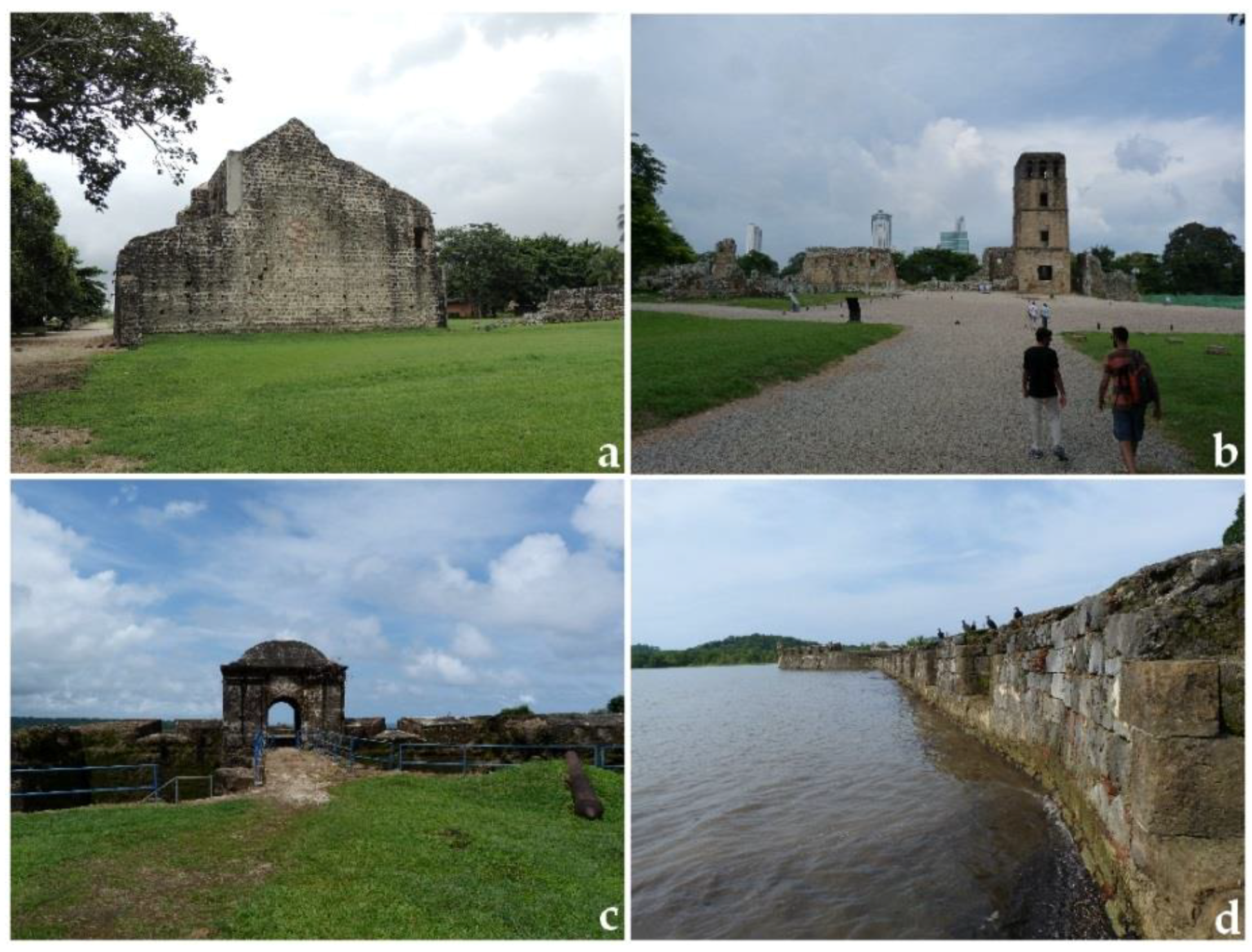
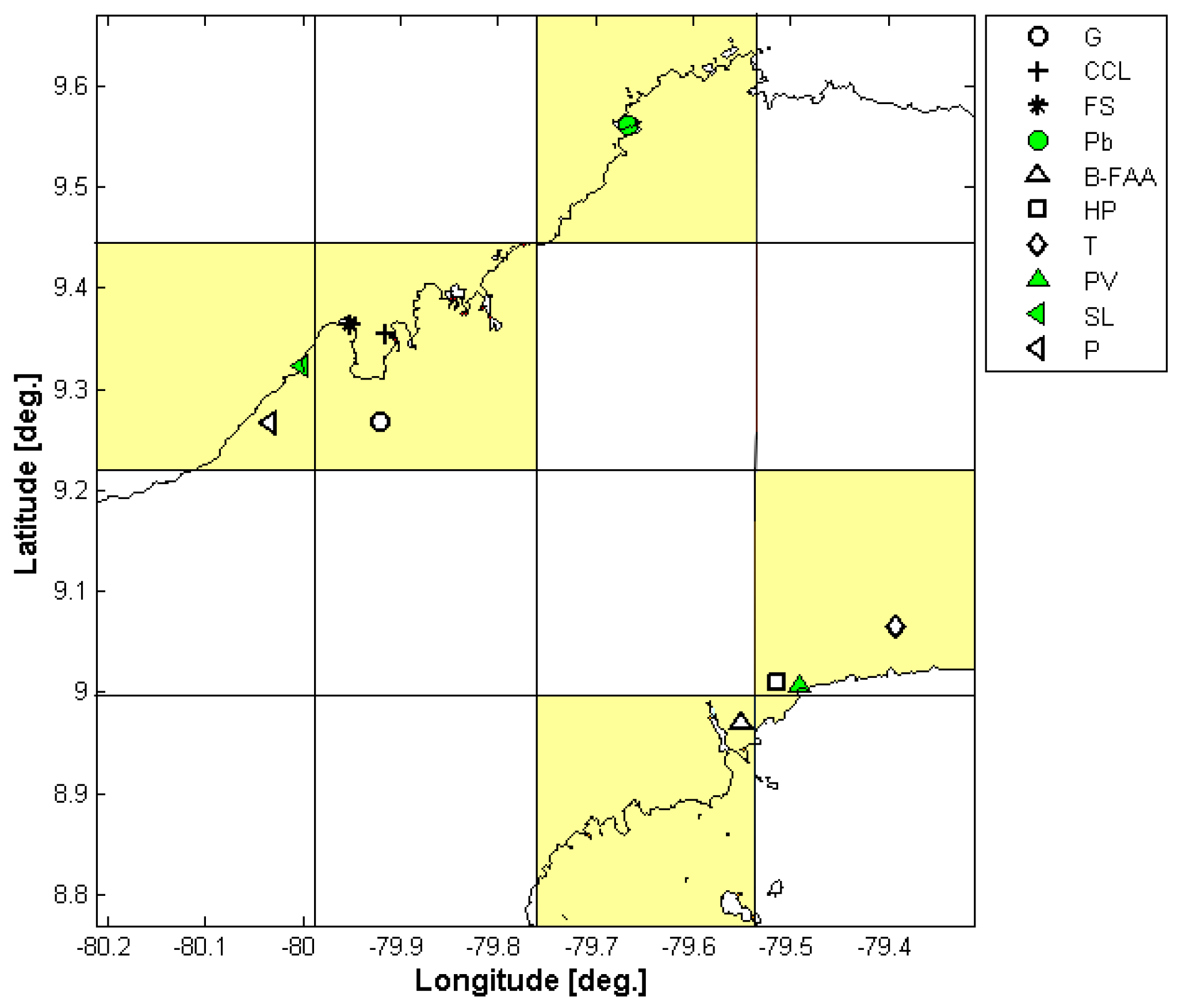
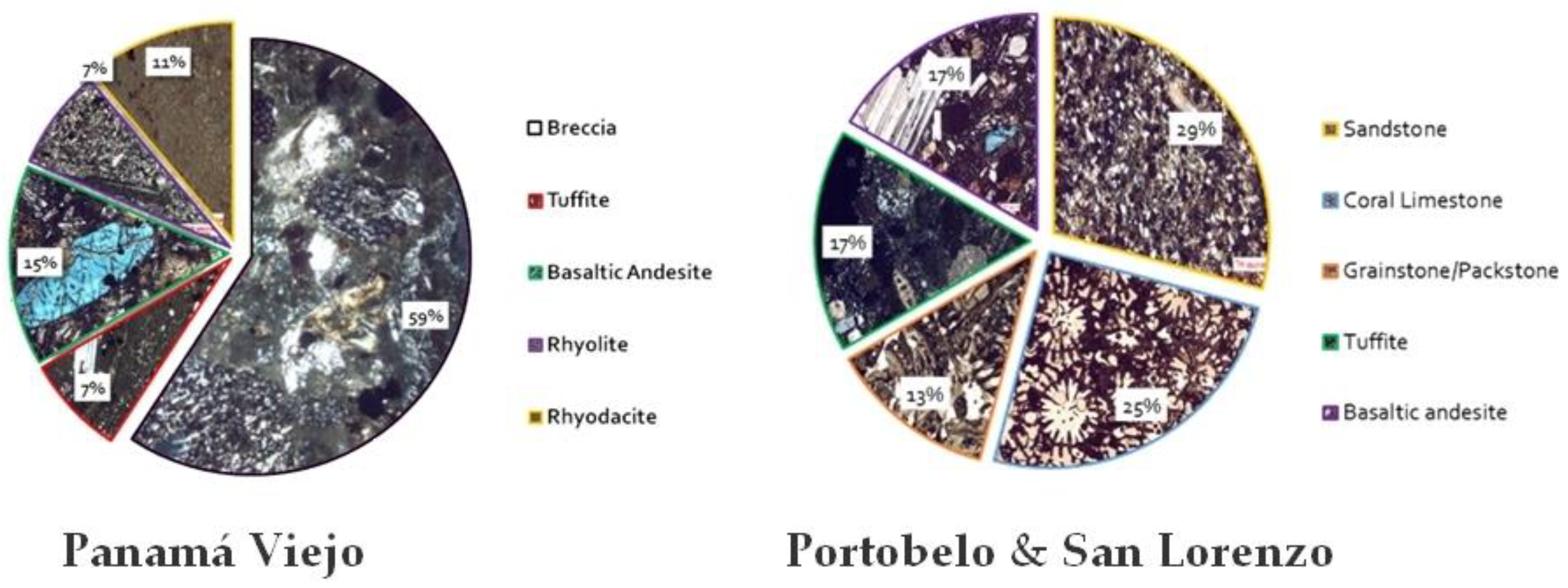
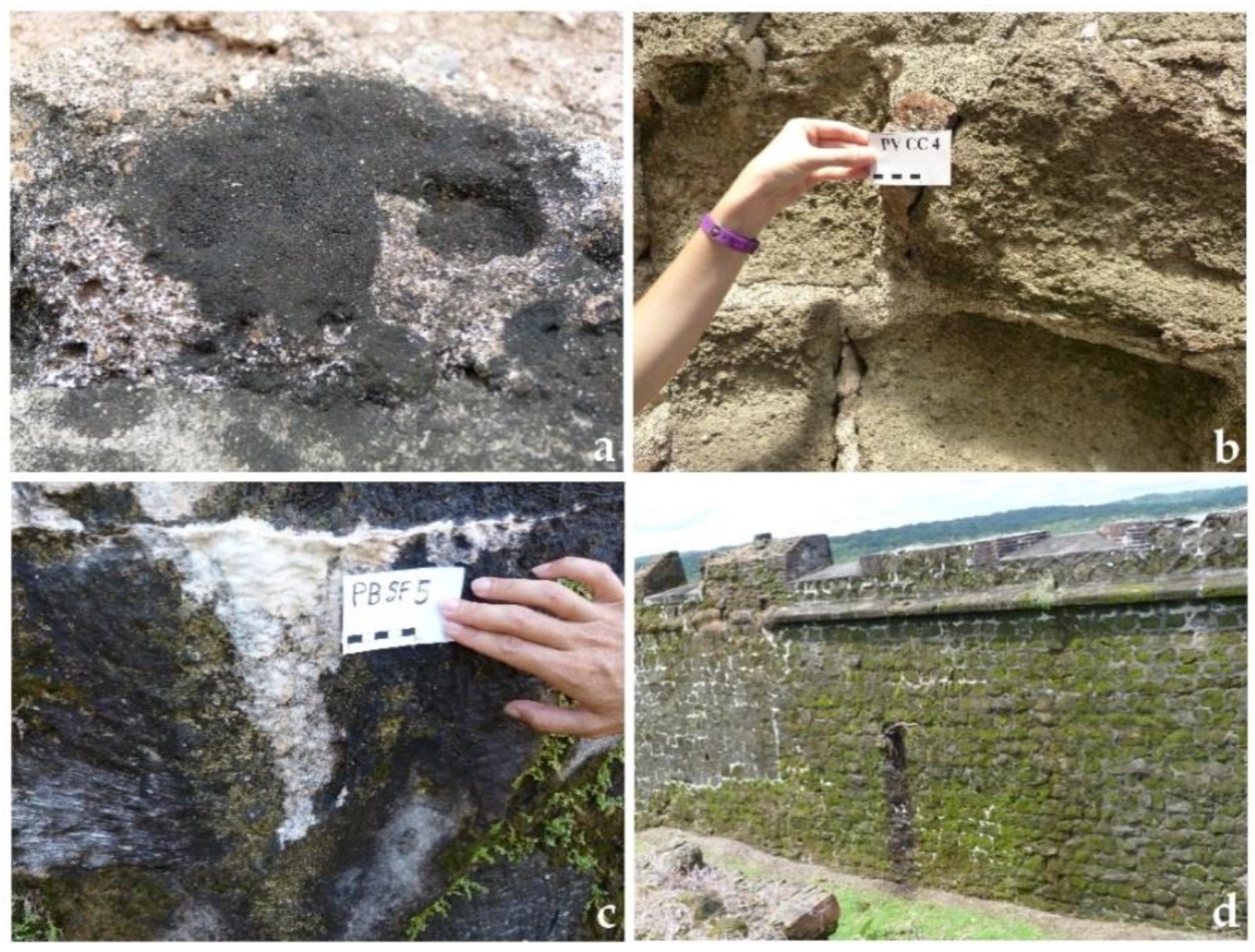

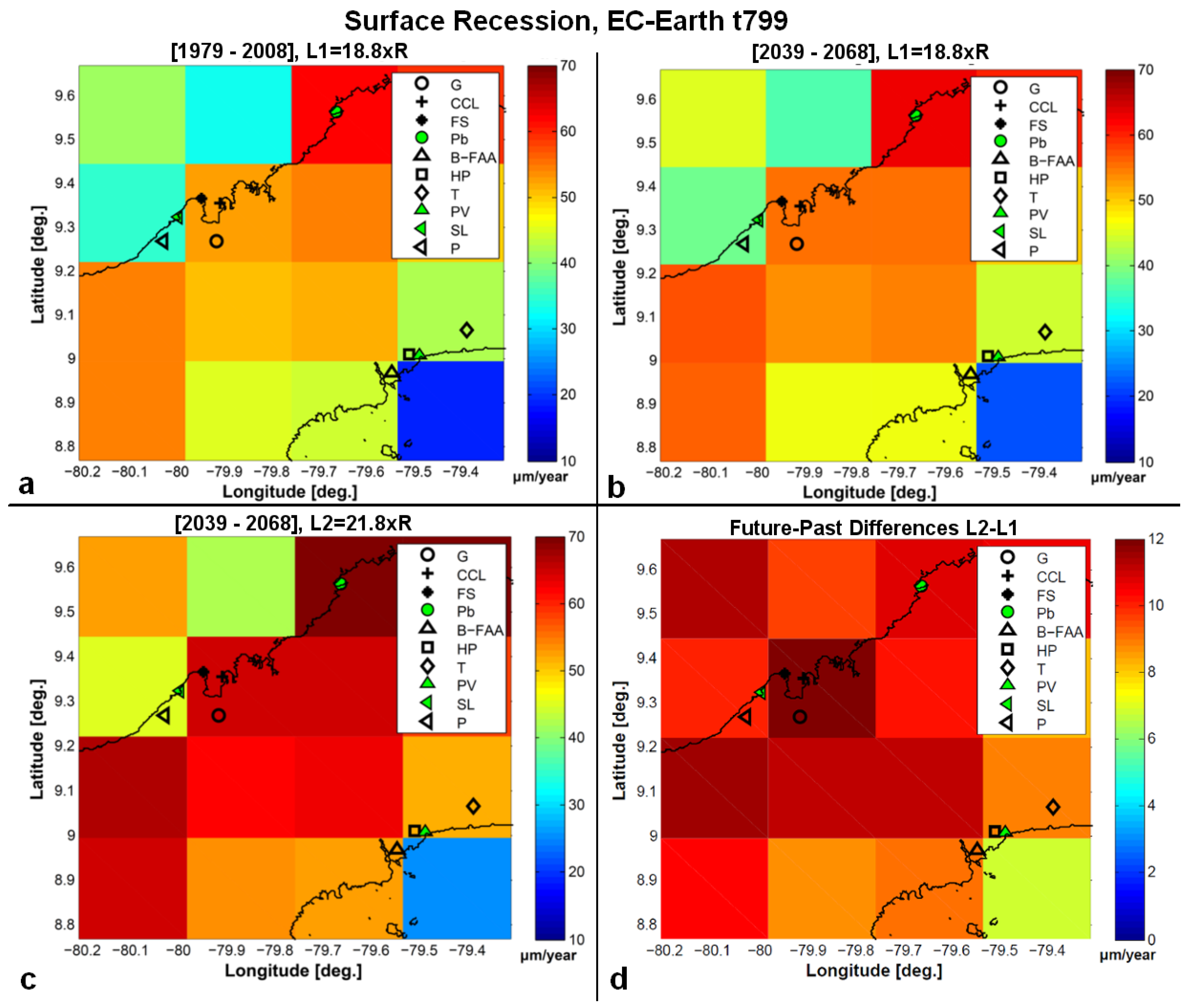
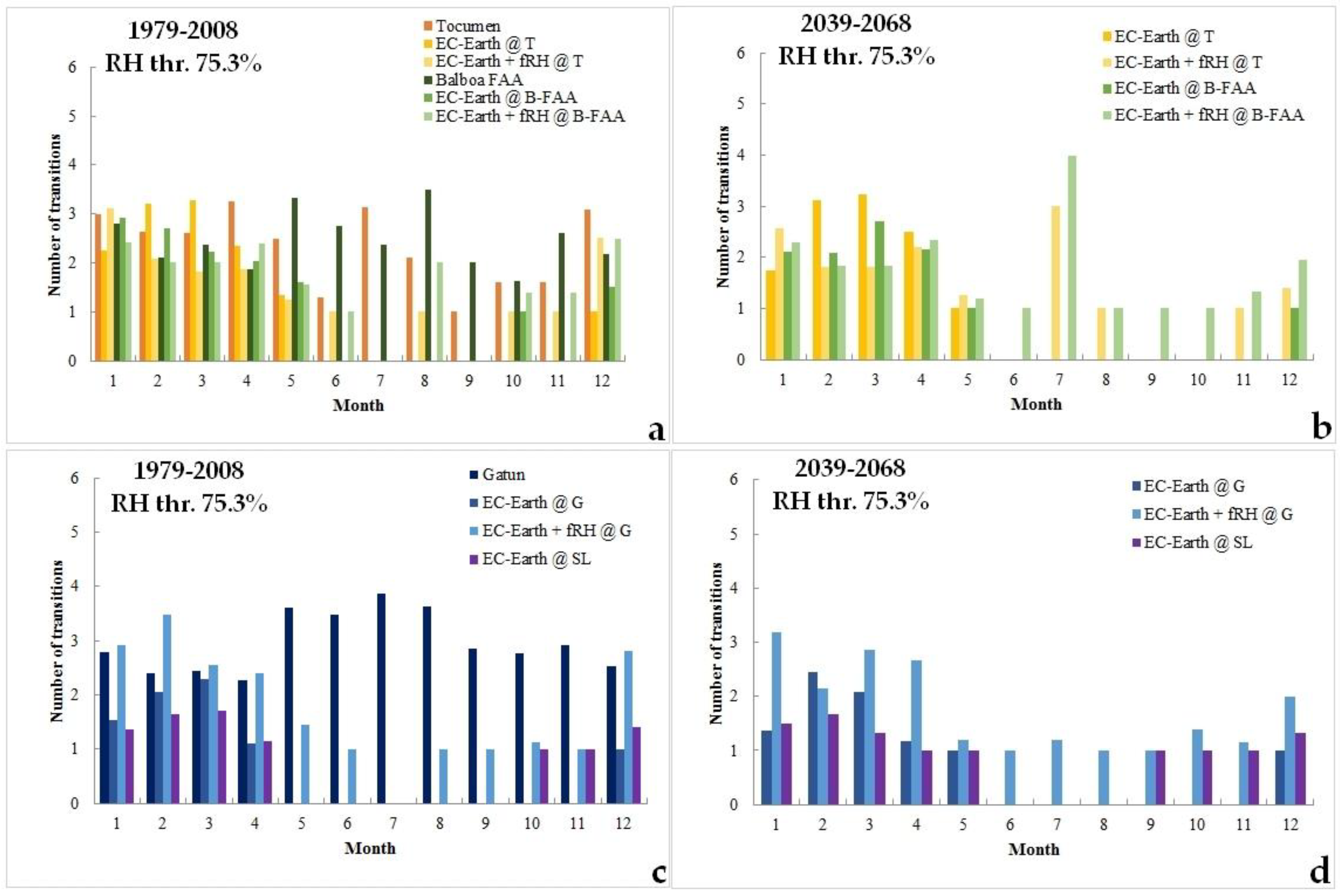
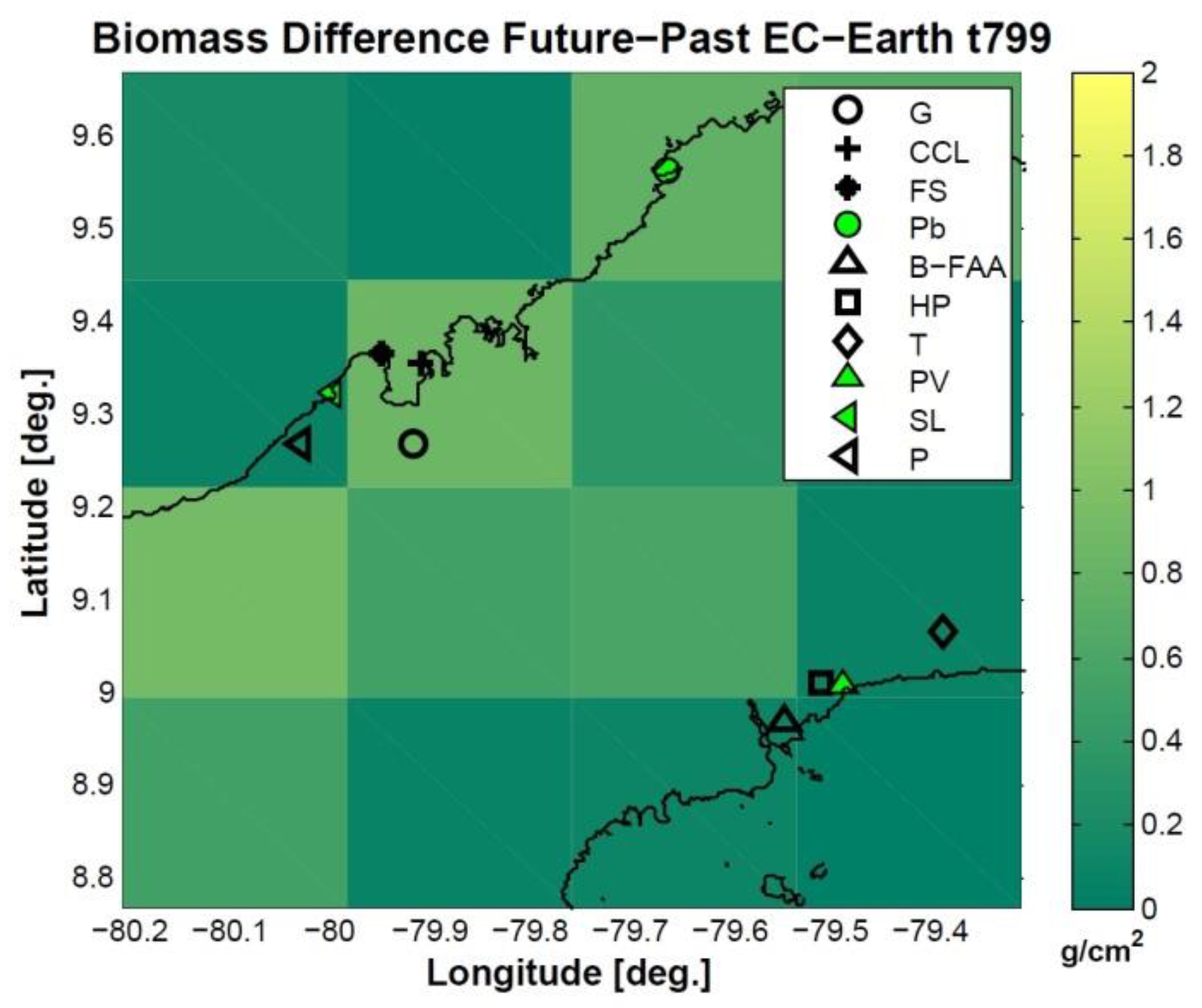
| Name | Label | Elevation (m) | Date | Available Climate Parameters | ||
|---|---|---|---|---|---|---|
| R | RH | T | ||||
| Hato Pintado | HP | 45 | 1 July 1987– | × | ||
| Tocumen | T | 18 | 1 January 1970–1 January 2013 | × | × | × |
| Balboa FAA | B-FAA | 10 | 1 January 1908– | × | × | × |
| Portobelo | Pb | 2 | 1 May 1908–1 January 2004 | × | × | |
| Gatun Rain Z.C. | G | 31 | 1 January 1905– | × | × | × |
| Cristobal | CCL | 8.5 | 1 October 1862–30 September 1979 | |||
| Coco Solo | 4.6 | 1 September 1980–30 June 1996 | × | × | × | |
| Limon Bay | 3 | 1 November 1996– | × | × | × | |
| Fort Sherman | FS | 9 | 24 April 1997–14 October 2014 | × | × | × |
| Pina | P | 3 | 1 December 1970–1 November 1998 | × | ||
| Panamá Viejo | ||||||||||||||
| Anions Concentration/ppm | Cations Concentration/ppm | |||||||||||||
| Lithot. | C2H3O2− | PO43− | C2O4= | CHO2− | NO2− | NO3− | SO4= | Cl− | NH4+ | K+ | Mg2+ | Na+ | Ca2+ | |
| Pol. Br. | Min | 3 | 0 | 0 | 25 | 0 | 39 | 162 | 382 | 0 | 0 | 15 | 287 | 0 |
| Mean | 18 | 6 | 45 | 40 | 5 | 1034 | 2140 | 1316 | 33 | 212 | 458 | 2414 | 3756 | |
| Max | 87 | 42 | 319 | 68 | 11 | 3551 | 11,525 | 3821 | 89 | 354 | 1123 | 10,076 | 27,884 | |
| Tuff. | 0 | 0 | 34 | 75 | 62 | 6352 | 3098 | 10,675 | 99 | 237 | 294 | 5306 | 33,039 | |
| Rhyod. | Min | 4 | 143 | 0 | 17 | 26 | 1033 | 634 | 1334 | 25 | 244 | 288 | 1518 | 1775 |
| Mean | 546 | 171 | 0 | 29 | 27 | 1042 | 705 | 1537 | 30 | 247 | 321 | 2595 | 1781 | |
| Max | 1088 | 199 | 0 | 41 | 27 | 1051 | 775 | 1739 | 35 | 250 | 353 | 3672 | 1787 | |
| Portobelo & San Lorenzo | ||||||||||||||
| Anions Concentration/ppm | Cations Concentration/ppm | |||||||||||||
| Lithot. | C2H3O2− | PO43− | C2O4= | CHO2− | NO2− | NO3− | SO4= | Cl− | NH4+ | K+ | Mg2+ | Na+ | Ca2+ | |
| Bas. And. | Min | 0 | 0 | 0 | 32 | 0 | 19 | 74 | 617 | 23 | 313 | 318 | 789 | 0 |
| Mean | 0 | 0 | 11 | 57 | 10 | 40 | 115 | 664 | 52 | 453 | 442 | 1013 | 2017 | |
| Max | 0 | 0 | 33 | 103 | 29 | 61 | 169 | 704 | 103 | 641 | 633 | 1377 | 2888 | |
| Tuff. | Min | 0 | 0 | 0 | 49 | 12 | 58 | 203 | 729 | 53 | 219 | 496 | 453 | 0 |
| Mean | 4 | 0 | 0 | 52 | 22 | 165 | 260 | 1545 | 238 | 368 | 562 | 714 | 32,204 | |
| Max | 12 | 0 | 0 | 56 | 35 | 343 | 326 | 2802 | 498 | 618 | 604 | 1217 | 33,233 | |
| Sandst. | Min | 0 | 0 | 0 | 15 | 0 | 35 | 132 | 316 | 85 | 306 | 938 | 277 | 32,356 |
| Mean | 6 | 40 | 0 | 35 | 0 | 160 | 182 | 974 | 94 | 636 | 1066 | 1337 | 38,644 | |
| Max | 16 | 67 | 0 | 50 | 0 | 369 | 222 | 1779 | 112 | 1160 | 1208 | 2576 | 49,087 | |
| Grainst. | 15 | 0 | 20 | 22 | 43 | 21 | 362 | 700 | 52 | 158 | 652 | 452 | 48,671 | |
| Cor. Lim. | Min | 0 | 0 | 0 | 38 | 13 | 62 | 408 | 495 | 0 | 0 | 0 | 0 | 34,328 |
| Mean | 10 | 0 | 8 | 49 | 35 | 68 | 529 | 590 | 159 | 153 | 147 | 545 | 46,709 | |
| Max | 28 | 0 | 24 | 60 | 66 | 71 | 634 | 766 | 255 | 311 | 231 | 846 | 59,090 | |
© 2018 by the authors. Licensee MDPI, Basel, Switzerland. This article is an open access article distributed under the terms and conditions of the Creative Commons Attribution (CC BY) license (http://creativecommons.org/licenses/by/4.0/).
Share and Cite
Ciantelli, C.; Palazzi, E.; Von Hardenberg, J.; Vaccaro, C.; Tittarelli, F.; Bonazza, A. How Can Climate Change Affect the UNESCO Cultural Heritage Sites in Panama? Geosciences 2018, 8, 296. https://doi.org/10.3390/geosciences8080296
Ciantelli C, Palazzi E, Von Hardenberg J, Vaccaro C, Tittarelli F, Bonazza A. How Can Climate Change Affect the UNESCO Cultural Heritage Sites in Panama? Geosciences. 2018; 8(8):296. https://doi.org/10.3390/geosciences8080296
Chicago/Turabian StyleCiantelli, Chiara, Elisa Palazzi, Jost Von Hardenberg, Carmela Vaccaro, Francesca Tittarelli, and Alessandra Bonazza. 2018. "How Can Climate Change Affect the UNESCO Cultural Heritage Sites in Panama?" Geosciences 8, no. 8: 296. https://doi.org/10.3390/geosciences8080296
APA StyleCiantelli, C., Palazzi, E., Von Hardenberg, J., Vaccaro, C., Tittarelli, F., & Bonazza, A. (2018). How Can Climate Change Affect the UNESCO Cultural Heritage Sites in Panama? Geosciences, 8(8), 296. https://doi.org/10.3390/geosciences8080296







